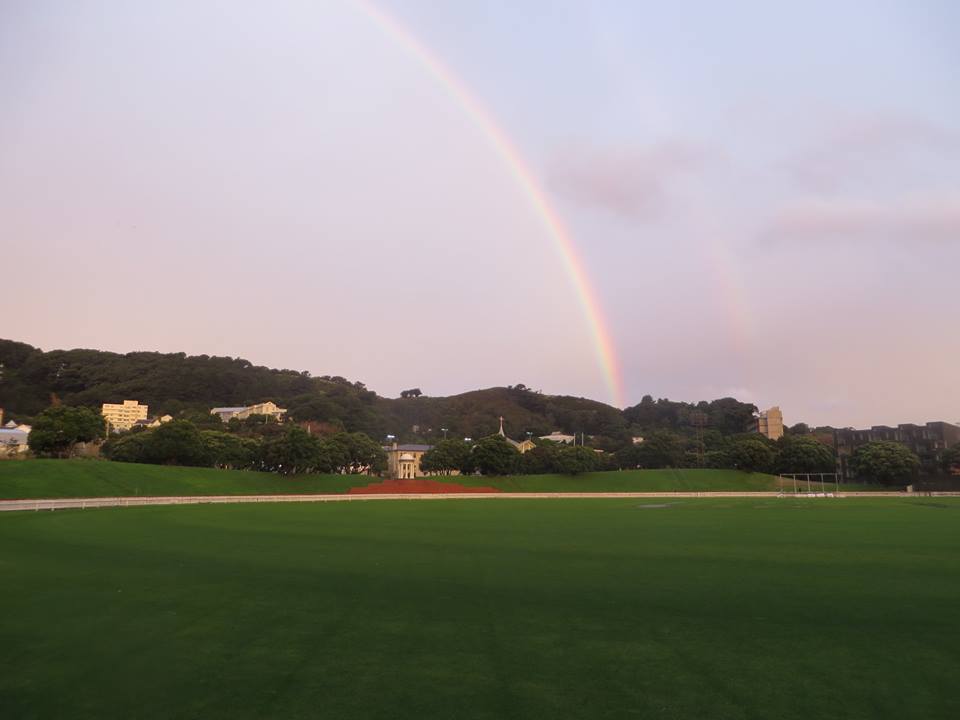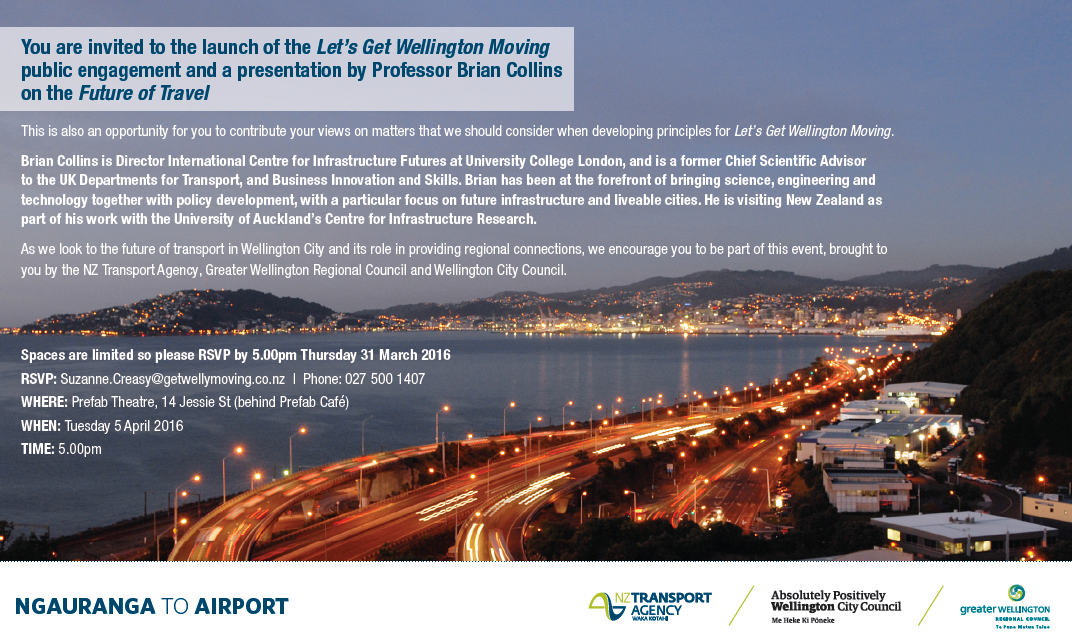The first phase of the Ngauranga to Airport Governance Group’s Let’s Get Welly Moving process, which is designed to find out what principles people in the Wellington region think should underlie Wellington transport planning, draws to a close at the end of May.
You can see the timeline of the full process here.
You can fill in the survey on the site, or if you want to engage in a deeper way, you can send your thoughts to info@getwellymoving.co.nz. That’s what Save the Basin decided to do – our submission to this first phase of the process is below, and you are welcome to adapt it for your own use. A number of these points build on our September 2015 Op Ed for the Dominion Post.
The next phase will be a call for proposals to rethink Wellington transport. We encourage you to put forward proposals that enhance Wellington role as a city for people, not a city for cars – and that ensure the Basin is not again put at risk.

Save the Basin Campaign Inc: Submission in response to the “Let’s Get Welly Moving” Engagement Phase
Introduction
As set out in its Constitution, the Save the Basin Campaign Inc has the following purposes:
(a) Promote, preserve and protect the historic character of the Basin Reserve area
(b) Promote high quality urban design and environmental management of the Basin Reserve area
(c) Promote an appropriate role for the Basin Reserve area in the development of a high quality, sustainable transport network, recognising the importance of the Basin to the public transport spine, and the importance of walkability and public transport for the users of the area
(d) Do anything necessary or helpful to the above purposes.
These purposes both explain why our Campaign was completely opposed to the proposed Basin Reserve flyover and took part in two successful rounds of legal action to prevent it gaining resource consent, and why we will oppose any future attempts to build a flyover or other transport infrastructure at the Basin Reserve that threatens the character, landscape, urban design or heritage of the Basin precinct – whether or not such infrastructure is presented as part of a larger package of resource consent applications.
Equally, however, these purposes allow us to participate in discussions about appropriate, sustainable transport developments that involve the Basin Reserve precinct, and thus we are pleased to see the breadth of the engagement process that the Ngauranga to Airport Governance Group has chosen to engage in as the first phase of its Let’s Get Welly Moving process.
Our submission covers three broad areas: the wider transport context, our comments and concerns about the rest of the planned consultation process, and our views on what should be done at the Basin Reserve.
Save the Basin took part in the development of the engagement and transport planning principles for the post-Basin environment submitted under the aegis of Grant Robertson MP, and those principles should also be regarded as part of our input to the engagement process.
The broader transport context
The present engagement process is being carried out at a time of rapid and disruptive change in transport thinking, transport behaviour and urban design – change which means that business-as-usual thinking is no longer appropriate.
These changes include:
- the Government’s signing of the Paris climate change agreements and its commitment to an associated greenhouse gas emissions reduction target, meaning that serious steps will need to be taken to reduce greenhouse gas emissions from transport
- increased readiness by both central and local government to fund and provide infrastructure for active modes and public transport
- the increasing acceptance that building new roads induces further traffic congestion, as amply demonstrated by many local as well as overseas examples
- the post-2007 breakdown of the previously accepted correlation between population growth and growth in VKT, as notably seen in changes in young people’s transport thinking and behaviour
- the advent of disruptive technologies such as the wider uptake of car-sharing arrangements; electric vehicles; and driverless cars, with their associated requirement for far less road space
- a refocusing of urban design, in cities as diverse as Seoul and New York, to put people first rather than cars first.
In our view, a prudent response to these developments by the Governance Group should be to focus on transport behaviour change while also looking to make incremental improvements in transport infrastructure that do not commit the city to major infrastructure developments which may well be rendered redundant by transport behaviour changes, and which would foreclose other, more appropriate responses.
The engagement process: comments and concerns
While we welcome the change in approach represented by the “Let’s Get Welly Moving” (LGWM) process, we still have some concerns about how this is being carried out, and suggestions for improvement:
Methodology and weighting of responses received
The first phase of the LGWM process has been carried out region-wide. However, given the potentially competing interests involved, we submit that there should be a methodology which gives most weight to those most directly affected by potential infrastructure changes along the Ngauranga to Airport Corridor: that is, those who live closest to them.
Calling for proposals
The next stage of the process includes calling for proposals. As such proposals can be both time-consuming and expensive to develop, especially for community groups with limited access to professional resources, we submit that the Governance Group should make available independent advice to assist those who wish to make proposals to do so – similar to the role the “Friend of the Submitter” plays in complex resource consent hearings.
Modelling: assumptions and processes
The modelling tool(s) chosen, and their underlying assumptions, will be of crucial importance in assessing the proposals received and developing scenarios based on them. Therefore, we submit that an “open Government data” approach should be taken to the development and use of these modelling tools. This approach should both
- allow and encourage the involvement of those in the wider community with expertise in the analysis and use of Government and modelling data to engage with the modelling process and challenge modelling assumptions and processes, with the aim of producing a modelling process that truly reflects the realities of the rapidly changing transport environment, and
- take account of the range of ways in which the Wellington transport system may develop.
Consultation on scenarios
This is currently scheduled for January to March 2017. However, our experience is that it is extremely difficult to get people engaged in consultation processes during January and early February due to family commitments over the summer holiday period. Therefore, we submit that this consultation period should not begin until February 2017.
The future of the Basin Reserve: Save the Basin’s position
We believe that the starting point for consideration of the Basin Reserve’s future needs to be the final report of the Basin Bridge Board of Inquiry. We are disappointed that, so far, this does not appear to have been the case. While the immediate response of the applicant was to comb the report for possible grounds for appeal – an approach which proved unavailing in the High Court – the Governance Group should instead pay careful attention to the Board’s findings, which make clear the significance of the Basin Reserve and its environs for Wellington and its residents.
As those findings make clear, a narrow, transport-only focus on the Basin won’t work. What is needed is a long term vision and plan to protect and enhance an iconic cricket ground, create more open and green space, end urban blight and develop a transport space that accommodates pedestrians, cyclists, public transport users and cars.
The Board identified that the following options were worthy of further consideration:
- the Basin Reserve Roundabout Enhancement Option (BRREO) – an at-grade option that doesn’t involve bridging or tunnelling;
- Option X proposed by The Architectural Centre; and
- a tunnel option suggested but then discarded by NZTA.
Given the rapid and disruptive changes to transport outlined above, we believe that the best option for the Basin is the one which involves the least infrastructure development and provides the most flexibility for future developments. This is the BRREO, or a similar at-grade option. However, the other options foregrounded by the Board should also receive careful consideration.
What should happen next? Here is our 7-point action plan, some of which is now underway:
- Reframe the Basin as a sporting, urban development and heritage area as well as a transport corridor.
- Create a master plan for the whole area. Its national significance needs to be given appropriate recognition: instead of seeing the Basin, Pukeahu National War Memorial Park, the Governor General’s residence, numerous local schools and the heritage of Mt Victoria as isolated pieces, the rich history of the whole area should be celebrated.
- Go through a robust process to evaluate transport options. Start by carrying out small improvements to bring relief to frustrated transport users, and evaluate these before considering whether a more expensive option is justified. Ensure that, following the Wellington City Council’s “transport pyramid” approach, the needs of walkers, cyclist, and public transport users are given precedence.
- Upgrade the Basin and strengthen and preserve the Museum Stand.
- Prioritise a Reserve Management Plan for the Basin (as already agreed by the City Council) that will establish key principles on how the ground should be preserved.
- Put in place heritage protection for the whole ground in the City Council’s District Plan.
- Re-develop Kent and Cambridge Terraces as grand public and private spaces, well connected to the Basin
The Basin Reserve is a place of local, national and (especially in its role as an international cricket ground) international significance. We support options that preserve and enhance its status. We do not support options that put that status at risk.
